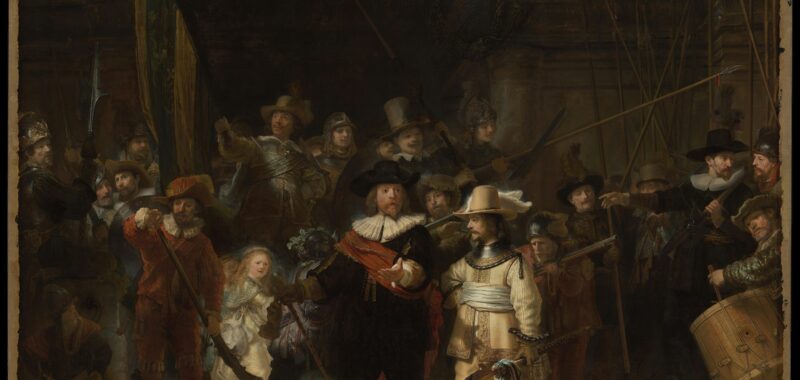Scientists say they have discovered the pigment that put the “Golden” in the Dutch Golden Age in Rembrandt’s paintings. New research into the paint Rembrandt used to represent glistening embroidery details in “The Night Watch” (1642) shows evidence of rarer arsenic sulfide mineral variants instead of orpiment, the more readily available pigment at the time.
The research team came together from the Rijksmuseum and the University of Amsterdam in 2019 for Operation Night Watch, an effort to preserve Rembrandt’s most ambitious masterpiece for centuries to come. The painting went through its last major restoration nearly 50 years ago following a slashing attack in 1975, and a less rigorous one in 1990 after an acid attack only managed to eat through the varnish. However, Rembrandt’s original paint selections haven’t withstood the test of time, as evidenced by a nearly completely faded rendering of a dog as well as the dark speckling on the face of one individual.
The most recent preservation efforts required various scans and tests to identify the materials Rembrandt employed and understand their chemical reactions with each other and external elements. To their surprise last year, the scientists discerned that he had prepared the canvas with a lead-based substance before applying a quartz-clay ground layer — a testament to the artist’s knack for experimentation.

The Operation Night Watch team also deployed various non-invasive analytical imaging techniques and paint sample tests to demystify Rembrandt’s signature gold detailing. They found that the Dutch Master incorporated “pararealgar and semi-amorphous pararealgar” — yellow and reddish-orange arsenic sulfide mineral variants that he mixed with lead-tin yellow and vermillion to achieve the glinting, reflective hue.
The team initially believed that Rembrandt had used the more historically present mineral orpiment due to its inclusion in two of his later works: “The Jewish Bride” (1665) and “The Man in a Red Cap” (c. 1665). Upon determining the presence of pararealgar and semi-amorphous pararealgar, the researchers hypothesized that both substances appeared in “The Night Watch” as a result of degradation over time. However, supplemental literary research into the availability, production, and use of both mineral pigments in the 17th century yielded an extensive paper trail of historical documents.

“Our research involved examining 17th-century trade records, apothecary pharmacopeias, price lists, and contemporary writings on metallurgy, painters’ manuals, and alchemical literature, including Danish historian Ole Worm’s Museum Wormianum,” wrote Nouchka de Keyser, one of Operation Night Watch’s researchers, in an email to Hyperallergic.
Expanding on the work of scholars such as Carolin Rötter, Guenter Grundmann, and Mark Richter, De Keyser specified that the team worked to determine how Rembrandt acquired the pigments, how they were produced and imported, and how much they might have cost, among other questions.
“We also studied a 17th-century collector’s cabinet from the Rijksmuseum, which includes various types of arsenic sulfides, hoping to match them with the pigments found in Rembrandt’s painting,” De Keyser continued. “This deep dive into the historical sources really allowed us to piece together a more comprehensive picture of these pigments in the market and how Rembrandt ended up using them.”

